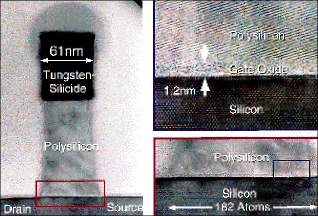World's smallest MOS transistor
sets stage for higher-performance ICs
Setting the stage for ICs that have billions of components on a single
silicon chip, a complete MOSFET–including source, drain, gate, and gate
oxide–has been fabricated that is four times thinner than the smallest
transistors in current integrated circuits. Fabricated by Bell Laboratories
(Murray Hill, NJ)–the research and development arm of Lucent Technology–the
experimental nanotransistor measures 60 nm or 180 atoms wide.
Although significantly thinner than current transistors now in use,
the transistor is setting records in speed, power consumption, and performance
characteristics in laboratory tests. In its on-state, the device delivered
a current flow of 1.8 mA/µm at 1.5 V, which is the highest current
flow ever reported for a MOS device. Its corresponding gate leakage is
less than 20 nA/µm2 .

Four times thinner than current IC transistors, a 60-nm-wide MOSFET
has been fabricated that is setting records in speed, power consumption,
and other performance characteristics.
The transistor sets a transconductance record of 1.12 S/mm. It is also
five times faster than today's devices, and draws 60 to 160 times less
power at 1 and 0.6 V, respectively, to perform an equivalent number of
operations. For example, the 60-nm transistor is specified for a 0.6-mA/µm
max on-state current at 0.6 V, while a 250-nm current-production device
exhibits a 0.7-mA/µm max on-state current at 1 V.
Key to the nanotransistor's development is its ultrathin gate-oxide
insulation layer that sits between its source and drain. The layer measures
1.2 nm or approximately three layers of an atom thick, which is five times
thinner than the gate-oxide layer in current transistor structures.
Also, to achieve the transistor's minuscule features, electron-beam
lithography is used instead of optical lithography. Because they are smaller
than light waves, electron beams are able to create smaller features in
the photolithographic process. For more information on the 60-nm transistor,
visit Bell Laboratories ' Web site at http://www.bell-labs.com.
–Sharon Richardson
Advertisement





